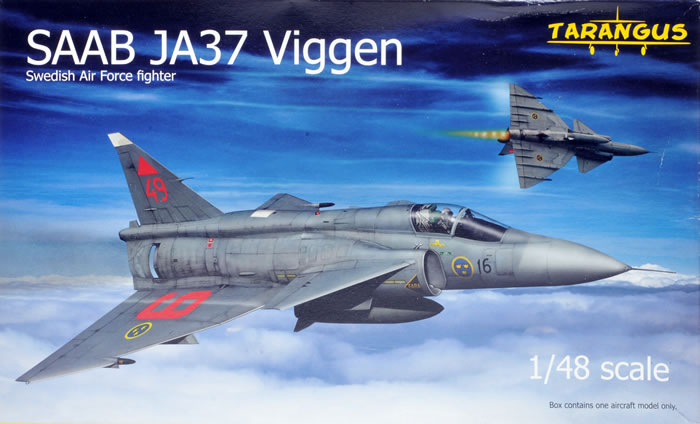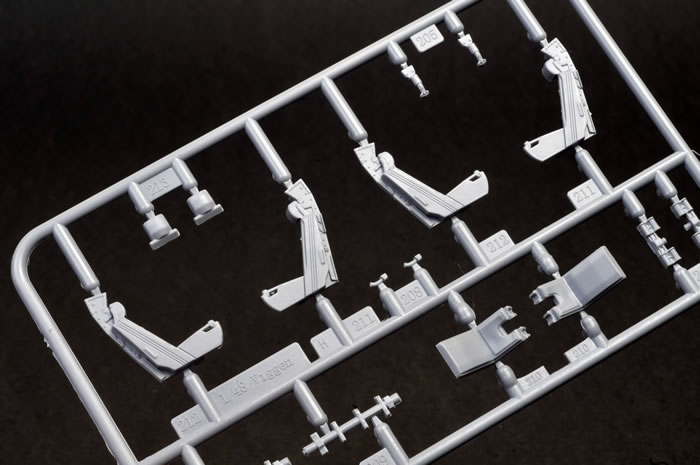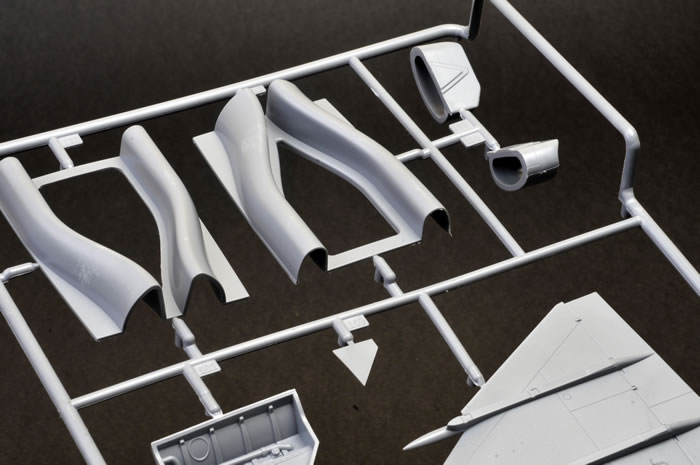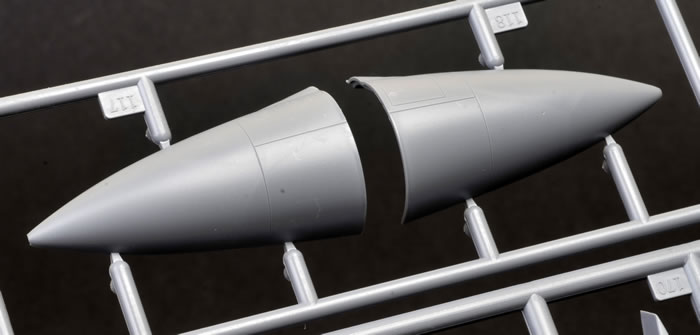|
SAAB JA37 Viggen

Tarangus, 1/48 scale
S u m m a r y : |
Catalogue Number: |
Tarangus Kit No. TA4803 - SAAB JA37 Viggen |
Scale: |
1/48 |
Contents & Media |
140 parts in grey plastic, ten parts in clear; markings for three subjects. |
Price: |
£64.99 (EU) or £54.16 (Export) plus shipping, available online from Hannants
and specialist retailers worldwide. |
Review Type: |
First Look |
Advantages: |
Welcome subject; high quality surface features; nice interior detail; good decals. |
Disadvantages: |
Short run kit so will need some care in alignment and assembly; no seat harness; detail missing in wheel wells. |
Conclusions: |
I highly recommend this kit for both accuracy and detail. |
Reviewed by Mick Evans

Valom's 1/48 scale An-2 Colt is available online from Squadron.com
Background
The SAAB 37 Viggen was initially developed as a replacement for the Saab 32 Lansen in the ground attack role and later the Saab 35 Draken as an air to air fighter.
The aim was to produce a robust aircraft with good short-runway performance that could be operated from numerous specially prepared roads and highways to reduce the vulnerability to attack in the event of war. Other requirements included supersonic ability at low level, Mach 2 performance at altitude, and the ability to make short landings at low angles of attack (to avoid damaging improvised runways). The aircraft was also designed from the beginning to be easy to maintain and service, even for personnel without much training.
To meet these design goals, Saab selected a radical configuration: a conventional delta wing with a small, high-set canard fore-plane. The final proposal was presented and accepted on 28 September 1962 with construction starting in 1964 and the first prototype maiden flight on 8 February 1967.

The Viggen was powered by a single Volvo RM8 turbofan. The RM8 was essentially a licence-built variant of the Pratt & Whitney JT8D engine that powered commercial airliners of the 1960s, but with an afterburner added for the Viggen. The airframe also incorporated a thrust-reverser to use during landings and land manoeuvres, which, combined with the aircraft having flight capabilities approaching a limited STOL-like performance, enabled operations from 500 m airstrips with minimal support. The thrust reverser could be pre-selected in the air to engage when the nose-wheel strut was compressed after touchdown. The Viggen was the first aircraft to feature both afterburners and thrust-reverser.
The AJ, SF, SH and SK 37 models of the Viggen had the first version of the RM 8A engine with uprated internal components from the JT8D that it was based on. Thrust was 65.6 kN dry and 115.6 kN with afterburner. For the JA 37 version, the RM 8A was modified to an 8B by replacing one LP compressor stage with a fan stage and improved combustor, turbine and afterburner. Thrust was 72.1 kN dry and 125.0 kN with afterburner (Wikipedia).
The Kit
Until this release by Tarangus the Viggen had only been released by the very old Esci kit of both the AJ and JA versions in the early 1980s and the later rereleased Airfix. The detail for the cockpit and wheel wells was very basic and sometimes non-existent, but when finished it definitely looked like a Viggen.
The kit had many shape issues in particular the nose, intakes, lower fuselage and engine exhaust.
A myriad of after-market parts to replace an upgrade the kit became available, in fact when I built mine I only used about 2/3 of the fuselage halves, fins, wings and weapons pylons. I replaced the following, cockpit, nose, intakes, engine front, lower belly of the fuselage, canards, engine exhaust, canopy, wheel wells, flaps/elevens, undercarriage, speed brakes, wheels and doors. I also added the RAT bay and some aftermarket weapons.
As usual, once I complete a project of this scale somebody produces the updated kit that negates all the conversion work.
Tarangus has not let us down with this release of the Viggen. During my conversion build of the old Airfix kit I became very conscious of the minor detail on the aircraft. On opening the box you are presented with 140 light grey plastic parts and 10 clear plastic parts.
Starting with the cockpit. The cockpit tub and instrument panel are sufficient in detail, while not to the standard of the resin aftermarket detail the kit parts will suffice for many builders. It includes separate throttle and radar controllers, control stick and rudder pedals. The raised detail on the instrument panel and side consoles is quite good and just requires some careful painting. The ejection seat is very good made up from five separate parts with quite good detail. Even the seat cushions have some contouring to them, something I have rarely seen in injection moulded kits. My only criticism is no seat harness detail is provided.

Engine front and intakes. Big kudos here, as full trunking is provided all the way to the compressor face of the engine. Five parts in all make up this assembly. The intakes look the correct shape and length and have an accurate slot cut into the lower lip.

Engine exhaust and thrust reversers. This area was one of the main failings of the Esci kit for accuracy. The prominent bugles on either side of the upper rear cowl were missing but Tarangus has captured these perfectly. They have also captured the detail of the thrust reversers, with cut outs in the tail cone for the reversers to sit in if fully open or the cut outs to be present when fully closed (reverse thrust) position. The afterburner section looks to be the correct length and has excellent detail for the afterburner fuel injector ring/flame holder and the turbine disc rear bearing cone. The overlapping liners are also well represented.
Wheel wells, undercarriage and doors. This was another poor area on the Esci kit. No worry here, as Tarangus have provided excellent wheel well detail with major structure detail visible and ducting where required. The undercarriage legs are superb in detail capturing in line axels and braking system on the main gear and the fine detail on the twin nose gear leg. The wheels have excellent definition on the hub detail and should make for relative easy painting. The undercarriage doors have excellent internal detail requiring no extra scratch building work. They have good hinge detail and really look the part.
The nose is the correct shape for the JA37 version as is the vertical stabiliser.

The canards have the elevators moulded in place with fine detail. This was an area that caused me some frustration with the aftermarket replacement parts for my Airfix kit. The flaps and ailerons are also moulded in place also with excellent surface detail. This would take some work if the modeller wishes to display them in the lowered or displaced position, something I would not recommend.
A centreline Aden gun pod is provided along with the prominent centre line external fuel tank. The forward fuselage canted missile pylons are provided but there are no underwing pylons provided. These will need to be scratch built or sourced from an old Airfix/Esci kit unless an aftermarket company provides them soon. The canopy and windscreen look great and are crystal clear.
Finally separate speed brakes are provided. The lower ones have great external detail but neither the upper or lower speed brakes have any internal detail nor are any actuators provided. Obviously they are meant to be modelled closed and will require a little bit of scratch building if you wish to display open.
Colours & Markings
Decals are provided for three air superiority grey aircraft schemes while decals are provided for one splinter scheme aircraft.

If you are choosing to do the splinter scheme I would highly recommend getting a set of Gator Mask frisket sheets to do this otherwise you will drive yourself insane with the hard edge masking.
A full set of stencilling is provided for the aircraft.
I highly recommend this kit for both accuracy and detail. Well done to Tarangus for first delaying the production to find a moulding company to produce a superb kit and then secondly delivering us a superb kit.
My only criticisms and both are very minor are there are no ejection seat harness provided moulded on the seats and no internal detail to the speed brakes.
Thanks to Tarangus for the review sample.
Review Text Copyright © 2015 by Mark Davies
Images Copyright © 2015 by Brett Green
Page Created 9 April, 2015
Last updated
9 April, 2015
Back to HyperScale Main Page
Back to Reviews Page

|
